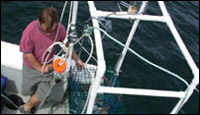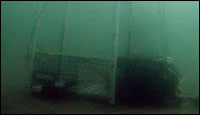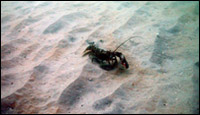Lobster Trap Video (LTV)
What is LTV (lobster trap video)?
LTV consists of a traditional two parlor lobster trap equipped with a time-lapse video recording system. We are able to obtain 24-48 continuous hours of video during each soak, depending on whether we use lights and record at night. We can then take these videos and analyze the movements and interactions of the lobsters around the trap.
LTV was first developed as part of a UNH Ocean Projects course, and then Sea Grant funds were used to improve it. If you would like to read any of the publications that resulted from using LTV, go the Publications section of this site.
What have we found?
1. Lobster traps are not very good traps. In this study they captured only 6% of the lobsters that entered, while 94% escaped. Most walked right back out the entrance (72%), while the remainder left through the escape vent (28%).
2. Lobsters are very active around traps during the day, as well as the night. This confirms other field observations indicating that lobsters in their natural habitat are not as strickly nocturnal as previously thought.
3. Agonistic encounters around traps appear to limit entry and stimulate exits. Small lobsters are very hesitant to enter, while larger lobsters tend to move right into the trap.
This Timelapse video shows lobster interactions both outside and inside of a trap: https://youtu.be/EmM8K3t4HTQ
4. When we combined diver surveys to accurately determine the density of lobsters on the bottom, we found that traps do not provide a very good index of the abundance of lobsters. However, when we used traps with the escape vents covered, the correlation improved. This is one reason many states currently use ventless trap surveys to help them assess the lobster population.
5. Most lobsters enter traps during the first 212-24 hrs of a soak, and catch peaks after 24 hrs when a balance between lobster entries and escapes is reached. This is due to both more lobsters escaping as the trap reaches "saturation" and a decline if the attractiveness of the bait.
Publications (for further details about our findings refer to the following publications:
Jury, S.H., W.H. Howell, D.F. O’Grady and W.H. Watson III. 2001. Lobster trap video: In situ surveillance of the behavior of Homarus americanus in and around traps. Mar. Freshwater Res.: 52: 1125-32.
Watson, W.H. III, W. Golet and D. Scopel. 2009. Use of ultrasonic telemetry to determine the area of bait influence and trapping area of American lobster, Homarus americanus, traps. New Zealand J. of Marine and Freshwater Biol. 43: 411-418.
Clark, AS, SH Jury, JS Goldstein, TG Langley and WH Watson III. 2015. A comparison of American lobster size structure and abundance using standard and ventless traps. Fisheries Research. 167: 243-251. doi:10.1016/j.fishres.2015.02.016
Clark, A.S, S.H. Jury, J.S. Goldstein, T.G. Langley and W.H. Watson III. 2018. Underwater video surveillance of American lobsters (Homarus americanus) to understand saturation levels in lobster traps. Fish. Bull. 116: 161-170. Doi.org/10.7755/FB.116.2.5
Watson, W.H., E. Morrissey, S. Sykes, A. Clark and S. Jury. 2019. Experimental analyses of the mechanisms leading to American lobster (Homarus americanus) ventless trap saturation. Fish. Bull. 117: 87-95.






